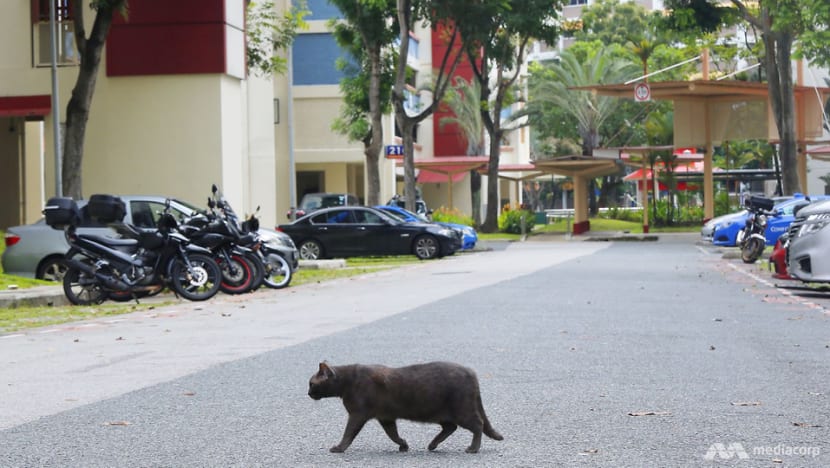2 cats in a flat? Welfare groups cheer AVS move but call for enforced sterilisation, 'responsible' ownership
While most groups welcomed the proposal to allow cats in HDB flats, some feline lovers are concerned about problems of abandonment and abuse.

File photo of cat in Singapore. (Photo: TODAY)

This audio is generated by an AI tool.
SINGAPORE: A proposal to allow two cats per Housing and Development Board (HDB) flat has drawn a mixed response, with some cheering the suggestion and others raising concerns about noise and potential conflict between neighbours.
Currently, HDB residents are not permitted to own pet cats, and offenders may be fined up to S$4,000 (US$3,000) under the Housing and Development (Animals) Rules.
Some people who spoke to CNA pointed out that the current ban on cats has not been enforced, and that there have been cases of cat hoarding in HDB flats.
Senior Minister of State for National Development Tan Kiat How on Saturday (Dec 2) unveiled a proposed cat management framework that would allow HDB households to own up to two cats per flat.
Under the framework, pet cats will need to undergo mandatory microchipping and licensing so as to allow authorities to respond to health outbreaks more effectively.
Owners will need to keep their cats in a safe environment and protect them from indoor and outdoor hazards, such as by installing window grilles, meshes or other barriers to prevent cats from roaming or falling from height.
Members of the public can share their feedback on the proposed framework through an online survey, which is available until Feb 1, 2024, said the Animal and Veterinary Service (AVS). The intention is to implement the framework in the later part of 2024.
VARIED RESPONSES
Retired pastor Lorna Khoo, 67, said it was “about time” that cats be allowed in HDB flats.
“I support (the proposal) very strongly. It should have been allowed a long time ago,” she told CNA. Dr Khoo said pets are good companions for elders in Singapore, and members of the Malay Muslim community cannot keep dogs.
“As long as their cats are microchipped, there’s accountability and responsibility,” she said.
But cat feeder and rescuer Steven Tor, 62, said he feared the proposal would make existing pet abandonment and abuse issues worse.
“All cats should be sterilised to stop breeding and this must be (made) mandatory for those who want to have a cat. This is not done,” he said.
Mr Tor, who is self-employed, said many cats get abandoned when they develop health problems or when their owners get tired of looking after them – and this does not seem to be addressed in the proposal to allow cats in flats.
The proposal will only make sense if present issues are contained and managed, he said. “(It) is about responsible ownership.”
Pushing the proposal through without enforcement would be “totally irresponsible”, he said, adding that the authorities should look into the problems that the community faces.
AVS said it intends to roll out next year a free sterilisation and microchipping programme for cats owned by low-income households. It added that it will organise roadshows and events to educate the public on responsible cat ownership.
Some people highlighted possible conflict between neighbours.
The Society for the Prevention of Cruelty to Animals (SPCA) said common complaints from neighbours of cat owners include hoarding of cats leading to unpleasant smells, cluttering the corridor with litter boxes, food and water bowls, and allowing cats to roam outdoors.
If the cats urinate or defecate indiscriminately when outdoors, this can inconvenience members of the public, said Ms Aarthi Sankar, SPCA’s executive director. Cat cages can also take up space in common corridors, and sometimes turn into a welfare issue if the cats are confined for long periods.
MANDATORY STERILISATION
Even among those who support the proposal, there were calls for sterilisation to be made compulsory.
“The SPCA welcomes the proposal, especially since we have long advocated for cat ownership in HDB flats and for more formal regulations,” said Ms Sankar.
“We also urge the authorities to consider mandating sterilisation for all pet cats (regardless of the number) to prevent accidental breeding,” she added.
Sterilisation can also address behavioural concerns such as caterwauling and contributes to overall feline health, she said.
AVS said on Saturday it would strongly encourage sterilisation of pet cats. Cat licences will have lifetime validity if the pet is sterilised and limited validity for those that are not sterilised.
Ms Thenuga Vijakumar, president of the Cat Welfare Society (CWS), said the lack of mandatory sterilisation is a “glaring lacuna” in the proposal.
“Even one cat will lead to a potential noise or roaming and marking complaint when it goes into heat,” she said, adding that the “best practice” is to ensure all pet cats are sterilised unless there is a vet-certified reason not to do so.
She said CWS was heartened to hear that AVS is considering overturning the ban on cats in HDB flats, and the society supports the need for licensing conditions.
CONCERNS ABOUT MISINTERPRETATION
CWS and SPCA both said there needs to be clear communication with cat owners who have more than two cats.
When announcing the proposed framework, Mr Tan said those who have more than two cats can apply to license and keep all their existing pets, subject to AVS’ approval and checks on the cats’ welfare.
“We believe that the biggest problem that could arise even now … is that the public will misunderstand the proposed threshold,” said Ms Vijakumar.
If that happens, those who have more than two cats may abandon or "recklessly give their cats away", she added.
CWS surveys in the past two years show that most cat owners have between one and three cats.
Ms Sankar also said that the SPCA is concerned that pet owners who have more than two cats may misinterpret the limit and let go of their cats.
“It is imperative that the authorities effectively communicate this flexibility to pet owners to avert any hasty decisions of abandoning their additional cats,” she said.


















